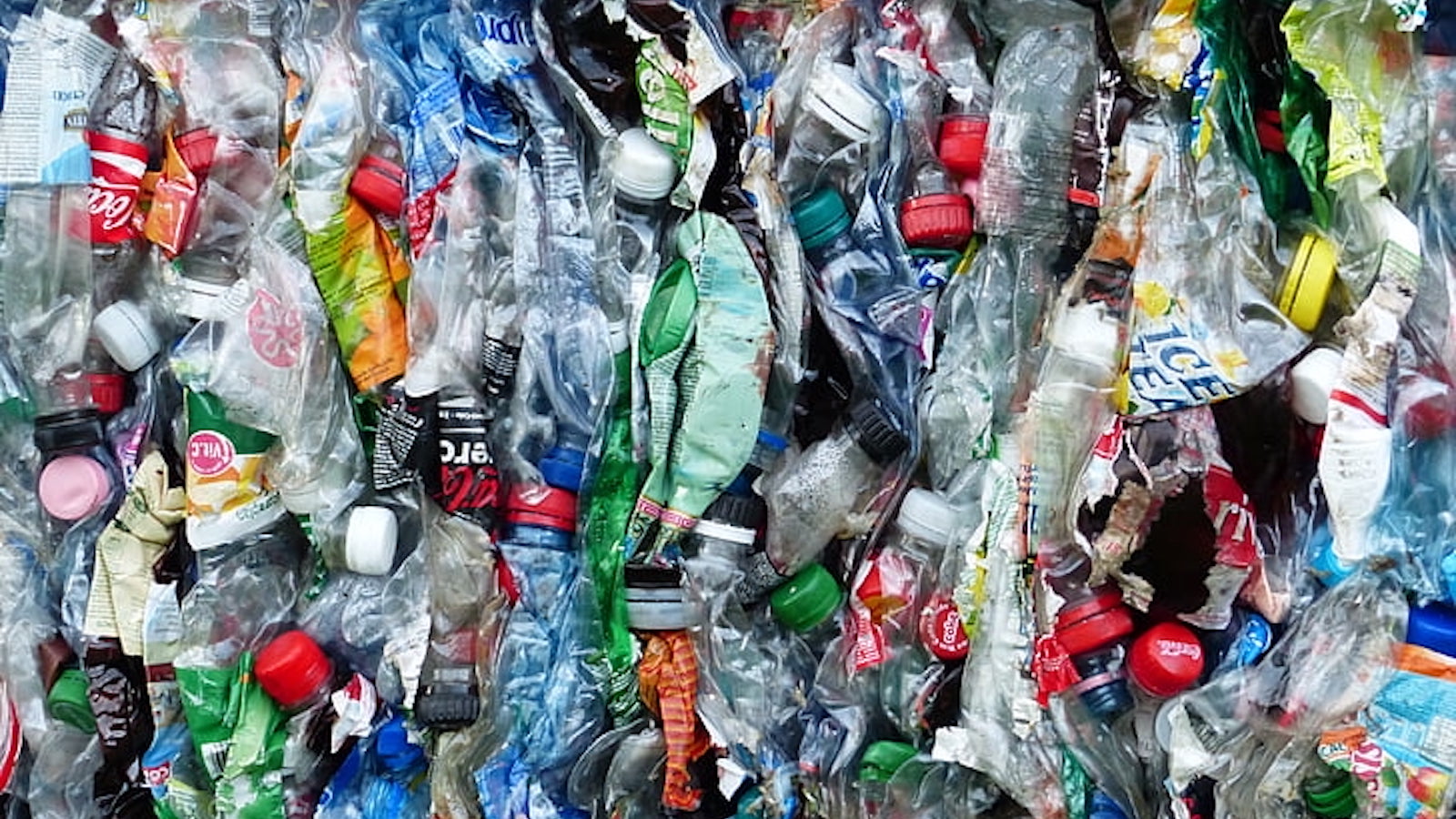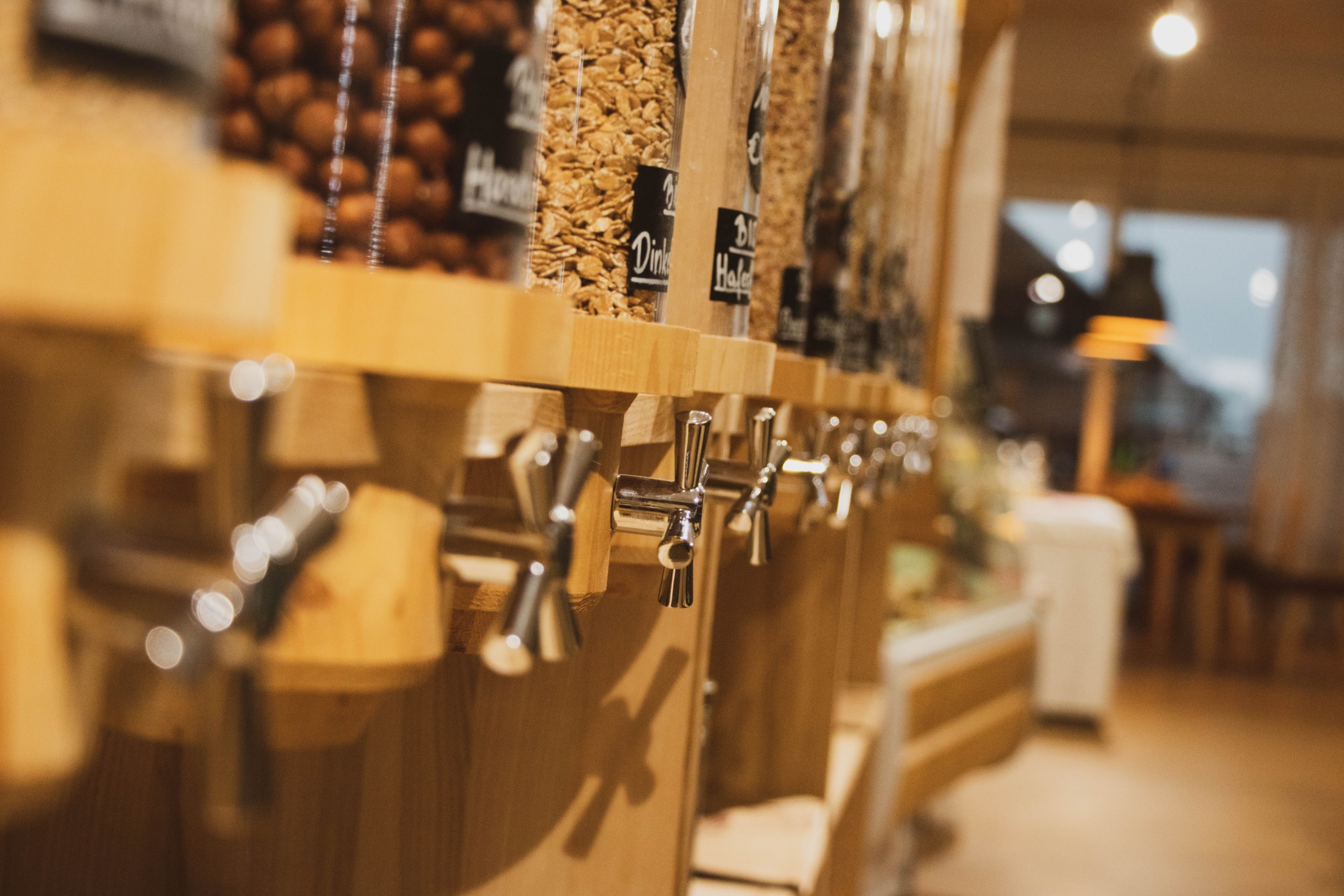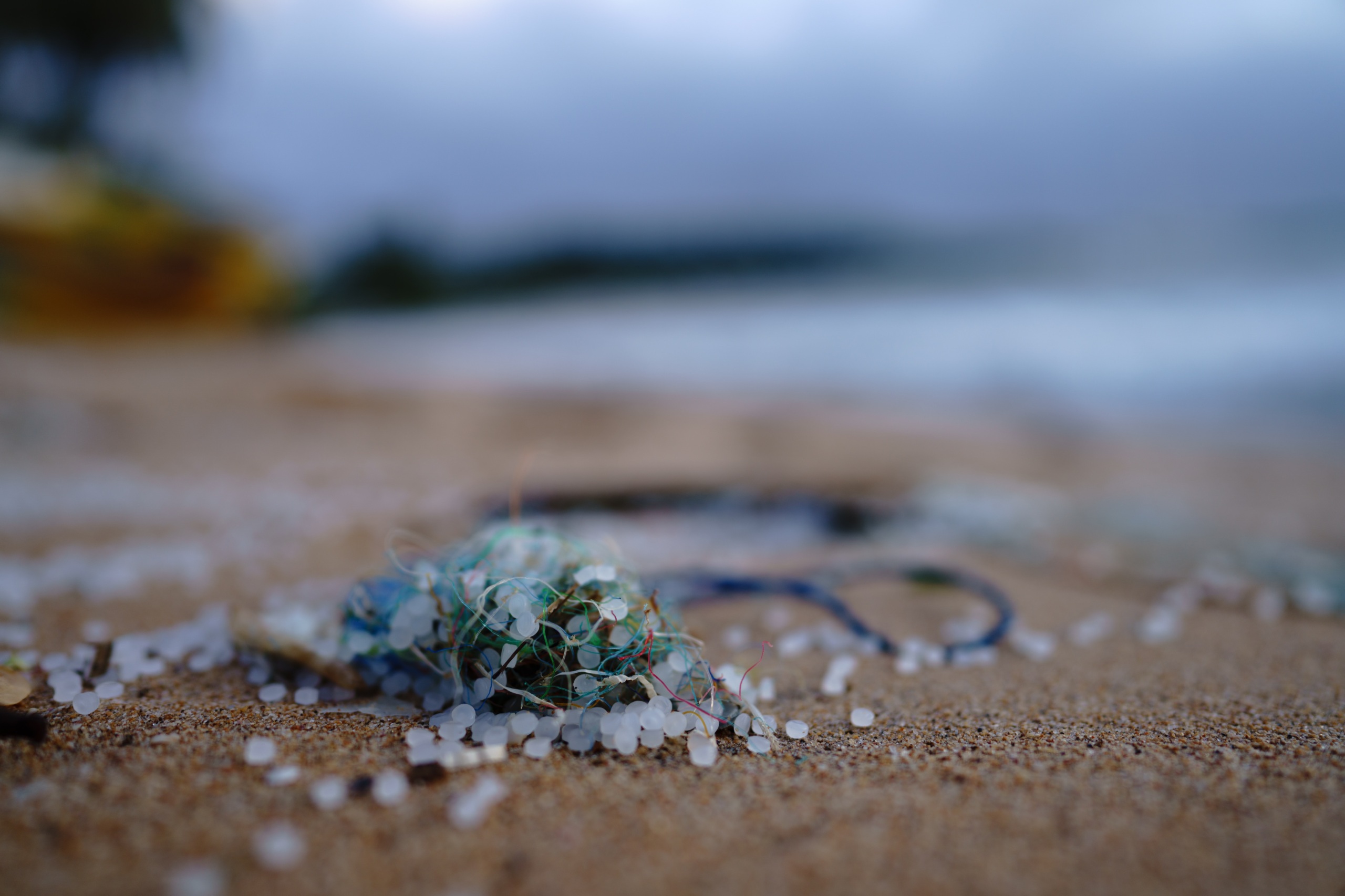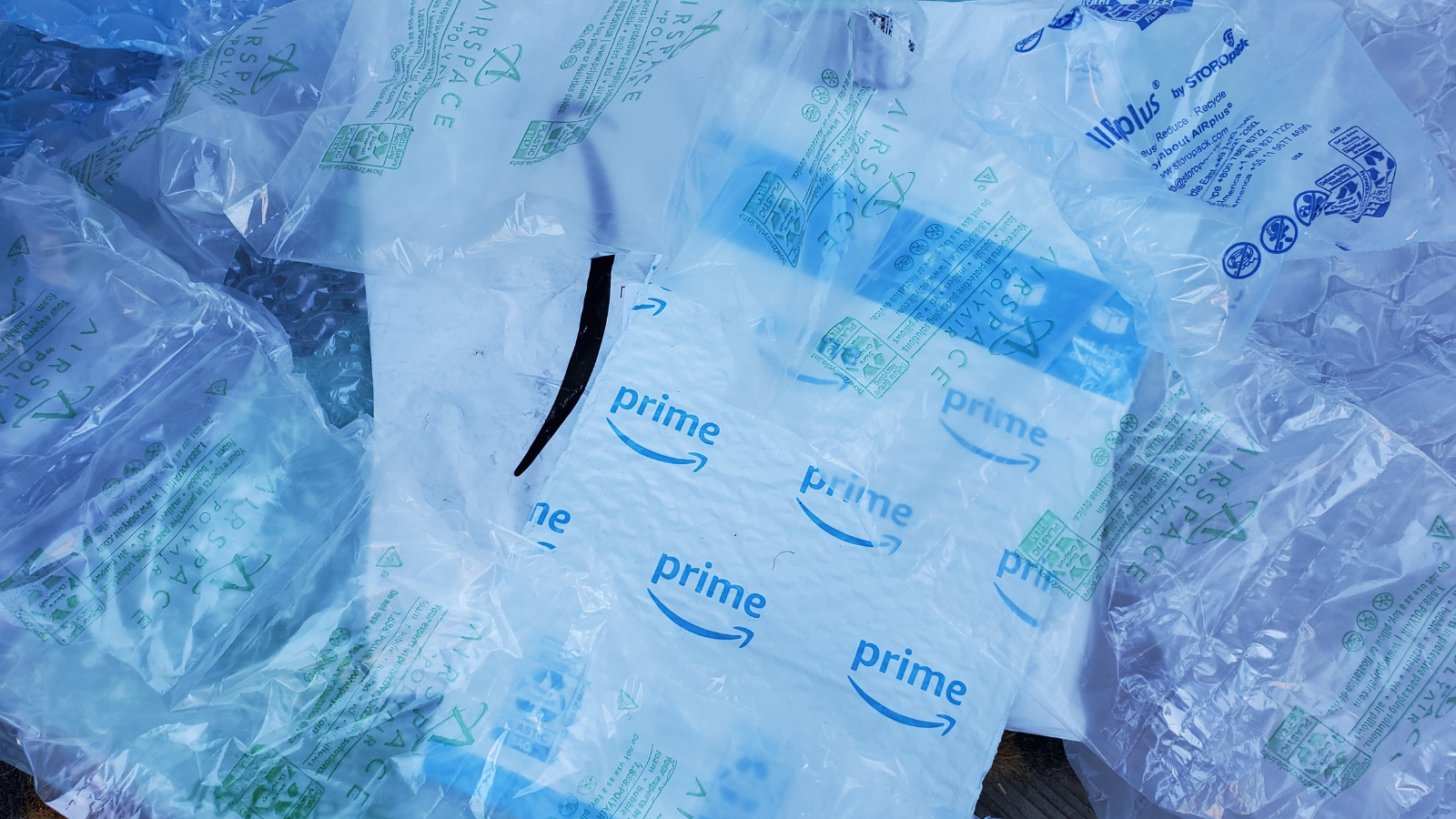
Frequently asked questions about recycling plastics
We get a lot of questions about recycling, especially recycling plastics.

Single-use plastics are flooding our lives. Designed to become waste within minutes after they are used, these one-time conveniences almost instantly become permanent pollution in our communities, our wild places and even the oceans.
Recycling seems like it should be a solution, but plastic is hard to recycle. In fact, less than 10% of all plastic ever made has actually been recycled.
The best way to slow plastic pollution is to stop producing so much wasteful plastic in the first place.
That said, sorting plastic waste into the recycling bin can prevent it from being immediately incinerated or landfilled, and that means less toxic pollution damaging our health and our climate. So what do we need to know to make our recycling habits effective?
Common questions about recycling plastic
I've heard that most plastics aren't recyclable– is that true?
Plastic as a material cannot be recycled again and again. Many types of plastics can’t be recycled at all, and others can only be recycled 2-3 times because the quality degrades every time the material gets recycled. Typically, pre-used plastic is more often “downcycled,” that is, turned into a product that is not recyclable or not as recyclable as the product from which it came. Downcycling can still help divert waste from the landfill or incinerator, but in the end, recycling plastic is not as sustainable or practical as recycling other types of material like glass or metal that can be recycled an endless amount of times.
Some types of pre-used plastic can be turned into a new consumer product, but the extent to which they can and the processes involved can vary widely based on the type of plastic, the recycling facilities available, and the local recycling infrastructure. It also happens less frequently than you may think– despite a lot of investment in plastic recycling infrastructure, less than 10% of plastics actually get turned into a new consumer product.
What are the different types of plastic and what do the numbers mean?
Plastics are generally categorized into seven main types, known as resin codes or plastic identification codes, which are indicated by the numbers 1 through 7 in the center of the “chasing arrows” recycling symbol that appears on the container. These codes indicate the type of plastic. Your local recycling rules should indicate which numbers are accepted for recycling in your area (along with size, shape, color, etc).
Different types of plastics have varying properties that affect their ability to be turned into another consumer product:
- PET (Polyethylene Terephthalate, resin code #1) – Used in bottles for beverages, food containers, and more. It’s widely turned into products like fiberfill for jackets, tote bags, and more bottles.
- HDPE (High-Density Polyethylene, resin code #2) – Found in milk jugs, detergent bottles, and plastic bags. It can be turned into items like plastic lumber, recycling containers, and more.
- PVC (Polyvinyl Chloride, resin code #3) – Used in pipes, vinyl flooring, and some packaging. Turning PVC into other products can be challenging, and it’s often not accepted in curbside recycling programs due to the presence of toxic additives.
- LDPE (Low-Density Polyethylene, resin code #4) – Found in plastic wraps, bags, and some containers. This type of plastic is less commonly accepted in curbside recycling but in some areas there are collection points for plastic film, like grocery stores– but there’s some evidence to suggest the plastic never actually makes it to a recycling facility.
- PP (Polypropylene, resin code #5) – Used in yogurt containers, bottle caps, and more. Can be turned into items like car components, landscape borders, and more.
- PS (Polystyrene, resin code #6) – Found in foam packaging, disposable utensils, and more. While some recycling centers accept PS, it can be challenging to recycle due to its lightweight and bulky nature. This plastic is also accepted by some so-called “chemical recycling” facilities, which converts plastic waste either into fuel or raw materials for new plastics. This is not recycling. Learn more.
- Other (resin code #7) – This category includes various plastics that don’t fit into the other categories, like polycarbonate and bioplastics. The recyclability of these plastics can vary widely.
Some plastics can be turned into other products, but successful recycling depends on a lot of factors like the type of plastic and the local recycling guidelines.
Which plastics are the most recyclable?
Less than 10% of plastics get turned into another consumer product (usually downcycled), so just because something is collected as recycling, doesn’t necessarily mean it’s getting turned into another consumer product.
Some types of plastics are more commonly collected in curbside recycling and have higher rates of being turned into another consumer product due to their properties and market demand for recycled materials:
- PET (Polyethylene Terephthalate, resin code #1) – PET is widely used for beverage bottles, food containers, and packaging. It is one of the most commonly recycled plastics and can be found in items like polyester fiber, clothing, tote bags, and more PET bottles.
- HDPE (High-Density Polyethylene, resin code #2) – HDPE is used in milk jugs, detergent bottles, shampoo bottles, and various types of containers. It’s often turned into products like plastic lumber, recycling containers, pipes, and more.
- PP (Polypropylene, resin code #5) – PP is commonly used in food containers, bottle caps, and some household items. It’s recycled into items like car components, landscape borders, brooms, brushes, and more.
These plastics are generally accepted in curbside recycling programs in many areas due to their demand in the recycling market and the availability of recycling infrastructure. However, it’s important to note that even these more recyclable plastics aren’t being recycled at high rates.
Other plastics, such as PVC (Polyvinyl Chloride, resin code #3), PS (Polystyrene, resin code #6), and LDPE (Low-Density Polyethylene, resin code #4), can be more challenging due to factors like toxic additives, contamination, limited demand for recycled materials, and technical difficulties in processing.
When it comes to recycling plastics, it’s important to follow local recycling guidelines, clean and empty containers before recycling, and educate yourself about the types of plastics accepted in your area.
Additionally, reducing overall plastic consumption, reusing items, and buying products and packaging made from more sustainable materials can contribute to a more effective and environmentally friendly approach to plastic waste.
Is it even worth recycling plastic?
Recycling plastic, if done right, could help conserve resources and mitigate pollution, but there are three major challenges:
- Consumer confusion: Recycling success depends on consumer participation, including proper sorting and disposal of plastics. But the appearance of the “chasing arrows” recycling symbol on almost all plastics, regardless of how recyclable the material actually is, confuses consumers and creates a barrier to meaningful participation in solving this problem.
- Limited Recycling Infrastructure: In some areas, the lack of proper recycling facilities and infrastructure can hinder effective plastic recycling.
- Plastic overproduction: Recycling will never be able to keep up with the sheer volume of plastic that is being produced. Many plastics can’t be recycled, and other plastics can only be recycled 2-3 times with the quality degrading each time it’s recycled– which limits the range of products that can be made from recycled plastic. When we recycle plastic, it’s as if the bathtub were overflowing and we started bailing out the water … before turning off the tap.
We’ve all heard the hierarchy of a comprehensive approach to waste: Reduce, Reuse, Recycle. When it comes to plastics, we need to focus on the first two Rs: Reduce and Reuse. We need to reduce plastic consumption, encourage a shift away from single-use products to more reusable and refillable systems, and also improve recycling of those plastic materials that are absolutely crucial to our health and wellbeing.
Does the recyclable label or chasing arrows mean anything anymore?
The definition of “recyclable” should be simple: You’d think a recyclable product is simply anything that gets broken down and re-used to create something new, preventing waste. But the reality is more complicated: One study found that “recycling” is defined in 18 different ways across the country.
The thousands of different community recycling programs nationwide don’t make it any easier, either. Changes to what these programs do and do not accept as recycling make it confusing for consumers like us, who just want to know what is environmentally friendly to buy and use, and how to dispose of it afterward.
PIRG is calling on the FTC to cut through the confusion by prohibiting the use of the word “recyclable,” the chasing arrows recycling symbol, or other statements that imply a product is recyclable … unless the item is actually recyclable.
In the meantime, pay attention to local recycling guidelines, familiarize yourself with the specific type of plastic you’re buying, and make informed decisions about recycling and waste disposal.
Where do I find out what plastic I can put in the recycling bin or take to a collection facility?
What you can and can’t put into your recycling bin or take to a collection facility depends on where you live. You should receive information about what can and can’t go in your recycling bin or collection depot from your local government and/or your recycling provider. If you haven’t gotten that information, give them a call. You can also find the information on How2Recycle or by googling “YOUR CITY + recycling.”
How do I find out if the plastics I am recycling are getting recycled?
Finding out if the plastics you put in your recycling bin or collection facility are actually getting recycled can be challenging, as the recycling process involves multiple stages and often takes place in specialized facilities. However, there are a few steps you can take to gain a better understanding of the recycling process in your area:
- Reach out to your local waste management or recycling center. They can provide information about the recycling processes in your community and whether the materials you’re recycling are being processed as intended.
- Look into the recycling facilities that handle your community’s recyclables. Find out what types of materials they accept and whether they have the capacity to process plastics.
- Some local governments or environmental organizations publish reports or updates on recycling rates and waste management practices. These reports may shed light on the fate of the materials collected for recycling.
- Attend workshops, seminars, or events organized by local environmental groups or waste management agencies. These events often provide insights into the recycling process and what happens to materials after collection.
- If your recycling is collected by a private waste hauling company, consider contacting them directly to inquire about their recycling processes and where the materials go.
- In some cases, recycling facilities may offer tours to the public. These tours can give you a firsthand look at how materials are sorted, processed, and prepared for recycling.
- Attend local community meetings or town hall sessions where waste management and recycling practices are discussed. This can provide an opportunity to ask questions and voice your concerns.
- Research the recycling guidelines in your area to understand which plastics are accepted for recycling. Properly sorting your recyclables can increase the likelihood that they will be processed correctly.
Remember that the recycling process can vary widely depending on your location, the infrastructure available, and market conditions. Even though you might not be able to track every piece of plastic you recycle, taking steps to educate yourself and engage with your local waste management authorities can contribute to a better understanding of recycling practices in your community.
What is chemical recycling?
Over the first two decades of the 21st century, the amount of plastic waste generated across the world more than doubled. Instead of embracing the only real solution – producing less plastic – the oil, gas and petrochemical industries have proposed their own answer, which they call “chemical recycling.” Chemical recycling is intended to convert plastic waste to fuel and new plastics. This is not a solution to the plastic waste crisis. It’s not really even recycling. If you’d like to learn more, read our resource, “Chemical recycling: What you need to know.”
Are bioplastics recyclable?
Biobased plastics are plastics that are made from plant material, not fossil fuels like gas or oil. Bioplastics aren’t always able to be recycled alongside petroleum based plastics, so it’s important to read the label to determine how to properly dispose of them at the end of use.
What is compostable plastic?
According to the Environmental Protection Agency, “In order for a plastic to be labeled as commercially ‘compostable’ it must be able to be broken down by biological treatment at a commercial or industrial composting facility.” If you live in an area with a commercial composting facility, you can look for ASTM D6400 or D6868 on the label to ensure that the product can, in fact, be commercially composted, check and make sure the facility near you takes the product and then take the steps necessary to make sure the product gets there.
Important note: When something is labeled “compostable,” it only refers to commercial composting. There is currently no official ASTM standard test to determine if a product will decompose in a home environment. Therefore, you should not compost these plastic products at home, unless the label specifically says it’s suited for home composting.
To learn more, read our quick guide to what some of these terms mean– or don’t mean– and some tips on meaningful ways you can help reduce plastic pollution.
How can I ensure that the plastics that I buy are recyclable?
Check your local guidelines to see which plastics are and are not accepted in your local recycling program. These guidelines can vary by region, so it’s important to know which types of plastics are actually collected in your area, and make your buying decisions based on that.
But here are some other ways you can make environmentally-mindful choices as a consumer:
- Avoid mixed material products. Products made from a mix of materials (e.g., plastic combined with metal or other materials) can be challenging to recycle. Opt for products made from a single type of material whenever possible.
- Prioritize other material types: plastic is difficult to recycle, so wherever possible opt for products that are fiber based or made from glass or steel.
- Find reusable options. Consider using reusable items made from materials like glass, stainless steel, or durable plastics that are designed for long-term use. Reusable products help reduce the overall demand for single-use plastics.
- Reduce your plastic use. Ultimately, one of the most effective ways to reduce plastic waste is to minimize your consumption of single-use plastics altogether. Choosing products with less packaging and opting for bulk items can help reduce your plastic footprint.
By following these steps and being mindful of the materials you choose, you can contribute to reducing plastic waste and supporting more sustainable consumption habits.
How well do I need to wash plastics before I put them in the bin?
Your local government or recycling provider will have specific guidelines, but in general you should rinse out plastic items before putting them in the recycling bin. They generally do not need to be perfectly clean, but should be free of food residue and dry before they go in your bin.
Does the color of the plastic matter?
Whether colored plastic is collected for recycling depends on the type of plastic and the recycling facilities available in your area. Some recycling programs might accept colored plastics, while others might have limitations or guidelines for accepting them. Check with your local recycling facility or municipality for specific guidelines.
Does the size of plastic matter?
Yes. You should check with your local recycling facility or municipality for specific guidelines, but in general small plastics– about 3 inches or smaller– can cause big problems for recycling equipment, so are typically not accepted.
If my local recycler doesn't take certain items, should I throw them in my recycling bin anyway and hope they get recycled?
No. You should only put things in your bin if your local recycler accepts it. It will cost the recycler a lot of money and energy to sort out stuff that shouldn’t be there. To make the recycling system work as efficiently as possible, only put stuff in the bin that belongs there.
Topics
Authors
Janet Domenitz
Executive Director, MASSPIRG
Janet has been the executive director of MASSPIRG since 1990 and directs programs on consumer protection, zero waste, health and safety, public transportation, and voter participation. Janet has co-founded or led coalitions, including Earth Day Greater Boston, Campaign to Update the Bottle Bill and the Election Modernization Coalition. On behalf of MASSPIRG, Janet was one of the founding members of Transportation for Massachusetts (T4MA), a statewide coalition of organizations advocating investment in mass transit to curb climate change, improve public health and address equity. Janet serves as Chair of the Board of Directors for the Consumer Federation of America and serves on the Common Cause Massachusetts executive committee, Alliance for a Healthy Tomorrow board of directors, and Department of Environmental Protection Solid Waste Advisory Committee. For her work, Janet has received Common Cause’s John Gardner Award and Salem State University’s Friend of the Earth Award. Janet lives in Cambridge, Massachusetts, with her husband and two sons, and every Wednesday morning she slow-runs the steps at Harvard Stadium with the November Project.
Celeste Meiffren-Swango
State Director, Environment Oregon
As director of Environment Oregon, Celeste develops and runs campaigns to win real results for Oregon's environment. She has worked on issues ranging from preventing plastic pollution, stopping global warming, defending clean water, and protecting our beautiful places. Celeste's organizing has helped to reduce kids' exposure to lead in drinking water at childcare facilities in Oregon, encourage transportation electrification, ban single-use plastic grocery bags, defend our bedrock environmental laws and more. She is also the author of the children's book, Myrtle the Turtle, empowering kids to prevent plastic pollution. Celeste lives in Portland, Ore., with her husband and two daughters, where they frequently enjoy the bounty of Oregon's natural beauty.
Find Out More

Ditch plastic packaging: Shop at your local refillery

Millions of tiny plastic pellets are being dumped into our waterways

Turning plastic waste into plastic lumber isn’t recycling


